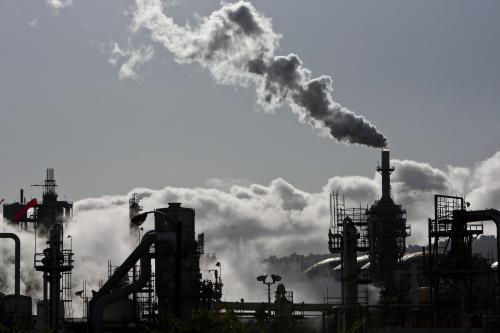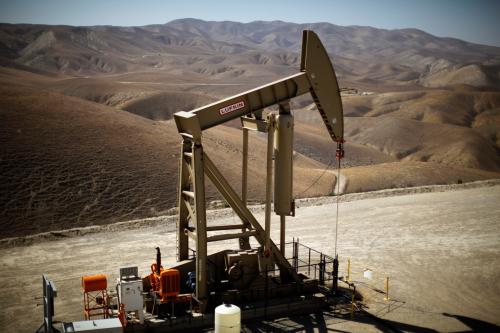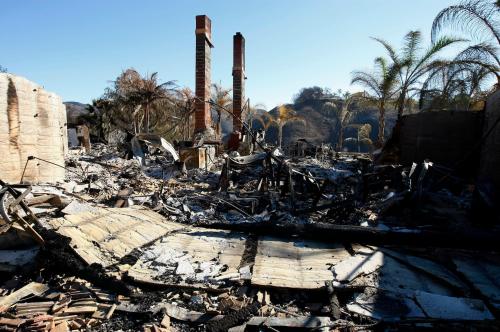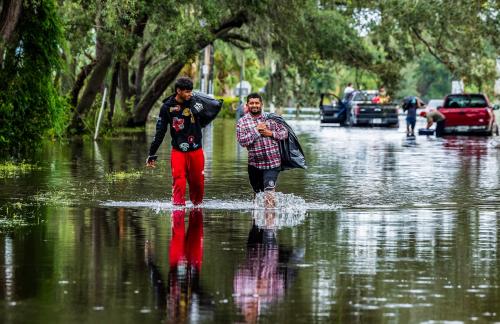As the Earth heats up, “decoupling” economic growth from carbon emissions growth is essential—for the world, nations, and localities alike. “Decoupling” is critical because it represents the only way to decarbonize the global economy while maintaining growth.
And progress is being made. In recent years, at least 35 countries, including the United States, have increased real gross domestic product (GDP) while reducing carbon dioxide (CO2) emissions. Long to short, a relatively encouraging juncture has been reached and seems to warrant cautious optimism about the campaign to limit global warming.
Now, though, some of the earlier optimism has slumped. With the stunning election of Donald Trump to the U.S. presidency, every aspect of the low-carbon paradigm for national and world progress has been thrown into question. No longer does it appear likely that America’s next national government will subscribe to the emerging global consensus that assumes the importance of “decarbonizing” the global economy by decoupling economic growth from emissions growth.
Which raises the issue of the resilience of decarbonization at the state and local level. States and cities, after all, represent an important possible counterweight to the likely coming period of climate skepticism in Washington. Furthermore, states especially retain much of the policy and legal power needed to reduce emissions.
And so today, we are releasing a new brief that provides a clear look at the status of state-side decarbonization at a time of federal pull-back. To that end, the brief reviews state-level decoupling trends in the United States by matching data on real GDP growth between 2000 and 2014 for all 50 states and the District of Columbia with data on energy-related CO2 emissions (for the same years and locations). In doing so, the brief—along with this cool data visualization tool from our colleague Alec Friedhoff—provides an initial survey of the pace and geography of state-side decoupling and decarbonization in the United States.
What do these data show? Overall, some 33 states delinked their growth and carbon emissions between 2000 and 2014, confirming that economic growth does not inevitably require emissions growth. To see what’s going on, take a look at the following state map and the set of small line charts below that.


A look at these graphics shows that, as a group, the 33 decoupling states expanded their economies by 22 percent while reducing their emissions by nearly 12 percent. Maine achieved the largest CO2 decline among the 50 states, at 25 percent, while growing its economy by 9 percent. Among the larger states (in terms of GDP), Massachusetts, New York, and Georgia saw some of the largest reductions in emissions since 2000. Massachusetts managed to cut its emissions by 22 percent even as its GDP grew by 21 percent. New York and Georgia decreased their emissions by 20 percent and 17 percent, respectively, while growing their GDPs by 24 percent and 15 percent. The pace of decoupling, meanwhile, has accelerated over time, with more and more states breaking the historically tight link between economic growth and emissions growth. For instance, in 2007, only 14 states had decoupled. In the years since then, however, the number has doubled, with new states like California, Georgia, New Hampshire, South Carolina, and Virginia joining the ranks of the delinked.
Overall, the state experience suggests that President-elect Trump’s assumption of an opposition between economic growth and environmental stewardship is false.
At the same time, though, the pace and degree of states’ decoupling vary widely, with distinct regional dynamics. This suggests that much more work remains to be done, with or without federal support. Sixteen states—including Arizona, Colorado, Iowa, and Oklahoma—have not decoupled and instead experienced rising emissions along with rising GDP. And a few states, including Nebraska and North Dakota, have shown dramatic increases in emissions.
Underlying this regional variation are differences in energy sourcing across regions. Northeastern and many Southern states have achieved some of the most impressive feats in emissions reduction and decoupling, largely due to favorable changes in these states’ fuel mixes, such as coal-to-gas power switching and increased reliance on nuclear energy. The shift toward cleaner-burning natural gas has enabled significant decoupling of growth from emissions in Connecticut, Delaware, Florida, Georgia, Massachusetts, and Virginia. Similarly, Georgia, Maryland, North Carolina, and Tennessee have supported their double-digit growth and emissions reductions in large part by sourcing a significant share of their electricity from nuclear power. Decoupling trends are relatively weaker in the Midwest and West due to these regions’ dependence on dirty coal for power generation and fewer nuclear plants providing zero-carbon power.
Many states, in short, have made impressive progress in reducing emissions and decarbonizing their economies. However, much more work needs to be done for the United States to come close to meeting the Paris goal of long-term decarbonization. For now, progress will depend heavily on market-driven trends like the glut of low-priced natural gas driving the massive coal-to-gas switch in the power sector. Beyond that, states and cities will need to lead progress in the next few years, even more so than in the recent past. Specifically, the goal must now be a bottom-up brand of American decarbonization strong enough to mitigate the worst costs of federal abdication, should the latter occur in the next four years.
We will have more to say about these topics in the coming weeks.
The Brookings Institution is committed to quality, independence, and impact.
We are supported by a diverse array of funders. In line with our values and policies, each Brookings publication represents the sole views of its author(s).







Commentary
Growth, carbon, and Trump: States are “decoupling” economic growth from emissions growth
December 8, 2016